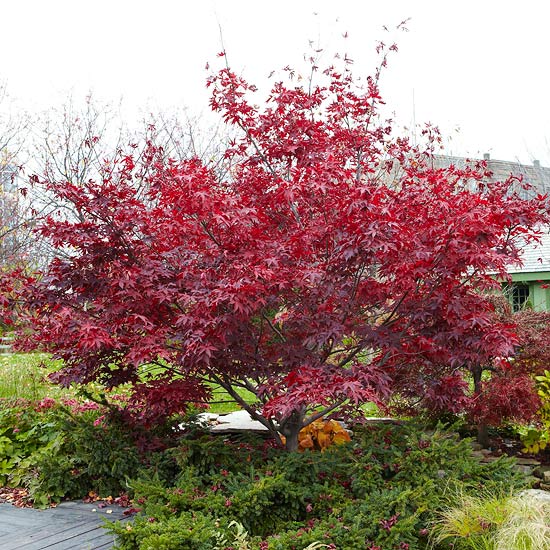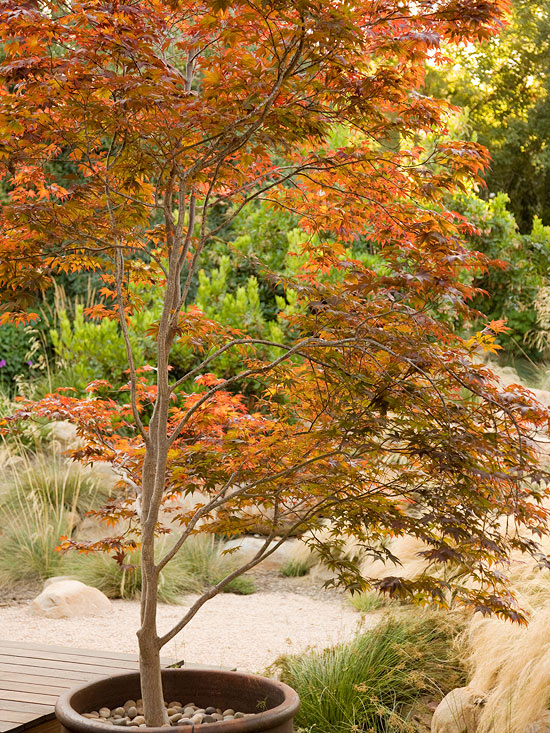





Japanese maples are fairly heat tolerant. References often list them as hardy up to Zone 7 or 8, but many gardeners successfully grow them in higher Zones. However, in hot, dry climates, the leaves will often scorch, therefore protection from the afternoon sun is important. Under a pergola or on the east or north side of a house is ideal. Also, green-leaf varieties -- less popular but just as garden-worthy as purple types -- may be a little less susceptible to leaf scorch than purple-leaf types. Either way, maples in arid climates require regular summer irrigation.
See our top 18 Japanese maple varieties.
 'Bloodgood', shown, and 'Emperor I' are two of the most cold-hardy Japanese maples.
'Bloodgood', shown, and 'Emperor I' are two of the most cold-hardy Japanese maples.
Many Japanese maples have a Hardiness rating of Zone 5 or 6, roughly 10 to 20 degrees below zero. Gardeners may experience problems in Zone 5 because of sun scald, which is cold damage due to premature emergence from winter dormancy. This frequently happens to maples planted on a south or west side of a home, which reflects warmth and causes the plant to "wake up" from winter prematurely, reducing its cold tolerance. The key to avoiding this in Zone 5 is to cover trunks with tree wrap and site the maples on the north side of a house (or away from it altogether). Also, mulch the ground at the base of the tree so the roots warm more slowly, keeping the plant dormant longer.
Many of the widely available varieties, such as 'Bloodgood' and 'Emperor I' have true Zone 5 hardiness, as do the closely related Acer japonicum (full moon maple) and A. aconitifolium (fernleaf maple). However, some cultivars only have Zone 6 or 7 hardiness, so it's always wise to check. If you live in Zone 5, try to stick with a variety that has a Zone 5 rating for a little more safety.
Learn more about growing trees and shrubs.
 Japanese maples grow happily in pots for years.
Japanese maples grow happily in pots for years.
In Zone 4, Japanese maples are simply not reliable in the garden. It's possible for them to survive a year or two if the winter lows aren't severe, but sooner or later, the weather will claim them unless they are in a very sheltered location such as a courtyard. Fortunately, maples are great container trees, and many Northern gardeners enjoy them this way.
Plant them in a large pot (be sure you have a way to move it -- it will probably be too heavy for one person to lift), and grow them outdoors spring through fall. Let the plant go completely dormant before storing it in an unheated garage or other cool but sheltered location. You want it to stay cold enough to keep plants dormant but not cold enough to damage them. Don't forget to add a bit of water every few weeks. The roots must not go completely dry, even when the plant is dormant.
Spring is the trickiest time for container maples. Be sure the plant is outside once the buds begin to open. Then be prepared to move it back to shelter during hard frosts. Fortunately, the window of time when this may be necessary is typically just a few weeks long.
Be sure to fertilize lightly at least once a season. With the tree growing in the same soil year after year, it will deplete the soil and need supplemental nutrition.
Japanese maples perform well in shade. As with any plant, they have their limits. But, along with dogwoods and redbuds, they are generally happy under the canopy of larger trees, on the north side of a house, or under a pergola, and they require no special care.
Their form changes substantially in shade (arguably for the better). Lower light prompts them to grow with a much more loose, open branching structure. Thus, the plant may have more impact for its form rather than its foliage in a shady setting.
Copyright © www.100flowers.win Botanic Garden All Rights Reserved